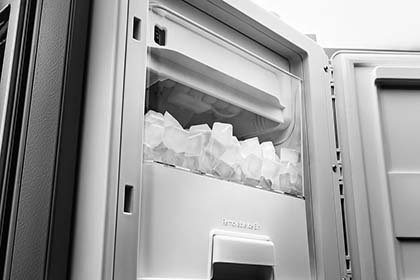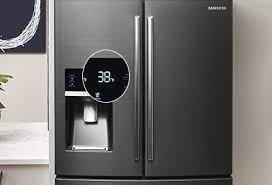Common Reasons for Fridge Ice Maker Problems

Causes:
- Clogged Water Lines: Sediment and mineral deposits in the water can accumulate over time, blocking the water supply to the ice maker.
- Faulty Water Inlet Valve: A malfunctioning or clogged water inlet valve can prevent water from entering the ice maker.
- Temperature Fluctuations: If the freezer temperature fluctuates too much, it can affect the ice maker’s performance.
- Defective Sensors: Sensors that monitor ice levels or temperature may become faulty or dirty, leading to inaccuracies.
Solutions:
- Clogged Water Lines: Regularly clean or replace water filters to prevent blockages. Flush the water lines if necessary.
- Faulty Water Inlet Valve: Replace the water inlet valve if it’s not functioning correctly.
- Temperature Fluctuations: Ensure your freezer is set to a consistent temperature, and avoid frequent door openings.
- Defective Sensors: Clean or replace sensors as needed to maintain accurate readings.
The Convenience of Having an Ice Maker
Benefits:
- Instant Ice: Enjoy ice on demand without the hassle of manual ice trays.
- Effortless Entertaining: Host guests with ease by providing ice for their drinks.
- Cooling Convenience: Quickly chill beverages and cool down on hot days with readily available ice.
How to Identify the Problem
Signs of Trouble:
- Unusual Noises: Grinding, clicking, or knocking sounds can indicate an issue.
- Reduced Ice Production: If the ice maker isn’t producing enough ice or the cubes are smaller than usual, there may be a problem.
- Misshapen Ice Cubes: Oddly shaped or cloudy ice cubes can signify issues with ice formation.
Step-by-Step Guide to Diagnosing the Issue
DIY Solutions for Common Ice Maker Problems

Common Issues:
- Clogged Ice Bin: A dirty or moldy ice bin can lead to poor ice quality.
- Frozen Water Lines: Frozen water lines can block water flow to the ice maker.
- Leaking Water: Water leaks can damage the ice maker and surrounding areas.
Solutions:
- Clogged Ice Bin: A dirty or moldy ice container can result in poor ice quality.
- Frozen Water Pipes: Frozen water pipes can block the flow of water to the ice maker.
- Leaking Water: Water leaks can damage the ice maker and surrounding areas.
Water Supply Issues
Causes:
- Low Water Pressure: Insufficient water pressure can prevent ice makers from filling properly.
- Clogged Water Filter: A dirty or clogged water filter can reduce water flow and affect ice quality.
- Water Inlet Valve Problems: Water inlet valve problems can interrupt the water supply to the ice maker.
Solutions:
- Low Water Pressure: Check the water pressure in your home and make sure it meets the ice maker’s needs.
- Clogged water filter: Replace the water filter according to the manufacturer’s recommendations.
- Water Inlet Valve Problems: If the valve is broken, replace it to restore proper water supply.
Stay tuned for the continuation of this guide, where we’ll explore more causes and solutions related to ice maker issues.
How to Check and Address Water Supply Issues
Causes:
- Blocked Water Line: A blocked or kinked water line can restrict water flow.
- Frozen Water Lines: In colder climates, water lines may freeze, impeding water supply.
- Low Water Pressure: Insufficient water pressure can prevent adequate water delivery to the ice maker.
Solutions:
- Blocked Water Line: Inspect the water line for obstructions, kinks, or damage. Clear any blockages and straighten kinks.
- Frozen Water Lines: Thaw frozen water lines using a gentle heat source to restore water flow.
- Low Water Pressure: Ensure your home’s water pressure meets the ice maker’s requirements. Consider installing a pressure regulator if needed.
Temperature Settings

Causes:
- Inconsistent Freezer Temperature: Fluctuating freezer temperatures can affect ice production and quality.
- Inaccurate Thermostat: A malfunctioning thermostat can lead to incorrect temperature control.
Solutions:
- Inconsistent Freezer Temperature: Adjust the freezer’s temperature settings to maintain a consistent environment for ice production. Avoid frequent door openings that can cause temperature fluctuations.
- Inaccurate Thermostat: If the thermostat is malfunctioning, have it calibrated or replaced to ensure accurate temperature regulation.
Adjusting and Optimizing Temperature Settings
Causes:
- Freezer Temperature Too High: If the freezer is set too warm, it can slow down ice production.
- Freezer Temperature Too Low: Extremely low freezer temperatures can cause other problems such as freezer burn.
Solutions:
- Freezer Temperature Too High: Lower the freezer temperature to around 0°F (-18°C) to optimize ice production without causing other problems.
- Freezer Temperature Too Low: Find the right balance between cold enough for ice production and not too cold to avoid freezer burn.
Ice Maker Components
Causes:
- Dirty or Malfunctioning Components: Accumulation of dirt or malfunction of components can hinder ice production.
Solutions:
- Regular Cleaning: Clean ice maker components like the ice mold and ejector blades to prevent blockages and maintain efficiency.
- Thermostat Check: Ensure the thermostat is functioning correctly to regulate temperature effectively.
Stay tuned as we continue to explore ice maker issues and their solutions in the subsequent sections of this guide.